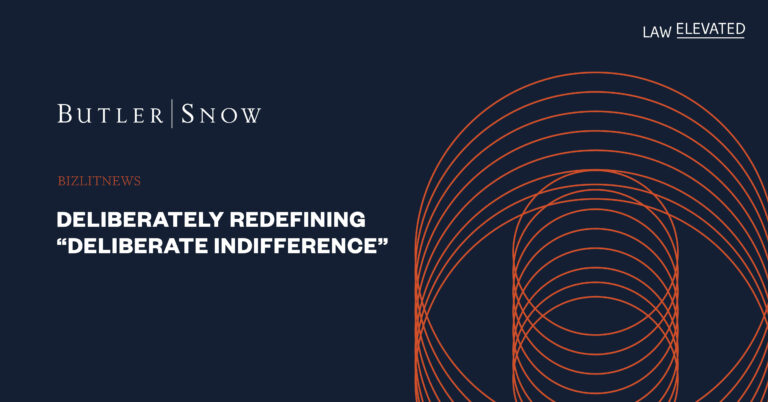As lawyers, we work with words. We bend them, conjoin them, manipulate them, and often seek to redefine them. Working in certain legal fields, we often take for granted the common vernacular used in those fields. Terms such as a “Brady violation” in criminal law, “qualified immunity” in law enforcement litigation, “genuine issue of material fact” for litigators, and “material adverse event” for business attorneys, take on unique significance in the fields where such terms are used. In corrections litigation, several terms shape legal cases, but there is one bedrock term that directly impacts every case concerning a constitutional violation: “deliberate indifference.” On July 10, 2024, the U.S. Circuit Court of Appeals for the Eleventh Circuit, in a unanimous en banc decision, readdressed this bedrock term and sent ripples through the corrections industry. Wade v. McDade, 106 F.4th 1251 (11th Cir. 2024). This decision directly impacts all departments of corrections and companies doing business inside prisons in Alabama, Florida, and Georgia.
“Deliberate indifference” traces its legal roots to a 1976 U.S. Supreme Court case, Estelle v. Gamble. In Estelle, the Court in deciding what constitutes an Eighth Amendment, cruel and unusual, violation of an inmate’s constitutional rights, stated “We therefore conclude that deliberate indifference to serious medical needs of prisoners constitutes the ‘unnecessary and wanton infliction of pain, [] proscribed by the Eight Amendment.’” Estelle v. Gamble, 429 U.S. 97, 105 (1976). Stated another way, an inmate suing a corrections official or vendor for a constitutional violation must prove the corrections official or vendor acted with deliberate indifference to the constitutional right of that inmate to be free from cruel and unusual punishment. The U.S. Supreme Court did not define “deliberate indifference” in Estelle, and it took almost two (2) decades before it set out to create the legal framework for this term. In 1994, the U.S. Supreme Court defined deliberate indifference as follows:
“[A] prison official cannot be found liable under the Eighth Amendment for denying an inmate humane conditions of confinement unless the official knows of and disregards an excessive risk to inmate health or safety; the official must both be aware of facts from which the inference could be drawn that a substantial risk of serious harm exists, and he must also draw the inference.”
Farmer v. Brennan, 511 U.S. 825, 837 (1994). This resulted in a two (2) part test that requires a plaintiff to establish: (1) an objective showing that he or she faces a substantial risk of harm; and (2) a subjective showing that the corrections official knows of the substantial risk and recklessly disregarded the risk (i.e., he or she consciously disregarded the risk).
Over the past three (3) decades, courts interpreted and reinterpreted the subjective requirements differently, introducing gross negligence to replace recklessness, and blurring the lines regarding the knowledge a corrections official needed concerning the substantial risk faced by the inmate or detainee. The Eleventh Circuit brought all confusion to an end, at least for the U.S. District Courts in Alabama, Florida, and Georgia, with its decision in Wade. Defining the standard for deliberate indifference, the Wade court stated:
“What is the standard establishing liability on an Eighth Amendment deliberate-indifference claim? []
1. First, of course, the plaintiff must demonstrate, as a threshold matter, that he suffered a deprivation that was ‘objectively, sufficiently serious.’[].
2. Second, the plaintiff must demonstrate that the defendant acted with ‘subjective recklessness as used in criminal law,’ [] and to do so he must show that the defendant was actually, subjectively aware that his own conduct caused a substantial risk of serious harm to the plaintiff—with the caveat, again, that even if the defendant ‘actually knew of a substantial risk to inmate health and safety,’ he ‘cannot be found liable under the Cruel and Unusual Punishments Clause’ if he ‘responded reasonably to the risk.’”[].
Wade, 106 F.4th 1261-62 (quoting Farmer, 511 U.S. 834, 839, 844-45). Not to understate the importance of the Wade opinion, Circuit Judge Jordan, writing in concurrence of the decision, cautioned attorneys to “look carefully at prior Eleventh Circuit cases to see if they are consistent with the subjective component of deliberate indifference set out in Farmer … [i]f they are not, then they probably have been abrogated to at least some degree by today’s decision.” Id. at 1265. In short, Wade’s a big deal!
Wade increased the burden on plaintiffs by eliminating a negligence based standard and reinstating a requirement to show a corrections official recklessly disregarded a known substantial risk “that his own conduct caused.” Further, Wade clearly articulated that no liability exists for any corrections official who, knowing of a substantial risk, acts “reasonably to the risk.” Based on the Wade opinion, departments of corrections and vendors facing Eighth Amendment constitutional challenges need to reevaluate their litigation strategies. Further, departments subject to consent decrees or injunctive orders should do the same. The standard articulated by the Eleventh Circuit provides clear direction for corrections officials to seek redress for long running court oversight and solid defenses to baseless claims.
